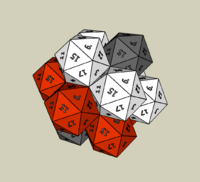Hello, I'm hoping to find the most accurate and proper name of this shape, if there is one, or for one to be named. I'm sure I'm overthinking it, but I'm just curious. It's simply 12 joined Icosahedrons, so my first thought was Dodecaicosahedron, but that doesn't seem right. I then thought maybe it's Octacontahecatohedron as there are 180 faces. The more I look at it though, the more I think I may not even be close. As there are some faces that make it no longer completely convex, I'm not sure if that alters the definition or not. Please post your thoughts, thank you.


